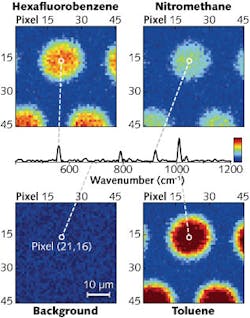MOLECULAR IMAGING: Frequency-comb-based Raman spectroscopy identifies molecules
Real-time, label-free molecular imaging has taken a major step forward with the development of a coherent Raman spectroscopy imaging method that uses two laser frequency combs to rapidly identify molecular species under a microscope.1 The technique is the result of a collaboration between researchers at the Max Planck Institute of Quantum Optics (Garching, Germany), Ludwig-Maximilians-Universität München (Munich, Germany), and the Université Paris-Sud (Orsay, France).
Called dual-comb coherent anti-Stokes Raman spectroscopy (CARS), the technique uses two femtosecond lasers with slightly separated repetition frequencies (about 100 Hz) to probe a mixture of molecules under a microscope. Although CARS methods can use a single ultrashort-pulse laser combined with a pulse shaper or an interferometer to probe molecules, the combination does not have the spectral bandwidth or resolution to identify different molecules in a mixture. But by using two femtosecond lasers, an entire Raman spectrum with a spectral bandwidth as broad as the inverse of the femtosecond pulse duration can be recorded on a microsecond scale, on a pixel-by-pixel basis, and by using just one photodetector.
Motionless frequency combs
In the experimental setup, two Ti:sapphire femtosecond frequency combs with 20 fs pulse duration and up to 13 nJ energy and pulse-repetition rate of 100 MHz are combined by a beamsplitter. A chirped-mirror compressor compensates for second-order dispersion induced by optical components in the setup, spectral filtering is used to improve signal-to-background ratio, and low-frequency bandpass filters before the sample and high-frequency bandpass filters after the sample isolate the CARS signal generated by the focused sample. The forward-collected anti-Stokes radiation is focused on a silicon photodiode (with a 100 MHz frequency bandwidth) and amplified and digitized for analysis.
Essentially, the nonlinear four-wave-mixing process for CARS is coherent when the energy difference between the pump laser and a Stokes laser is resonant with a Raman molecular transition. Probe-beam scattering generates a frequency-shifted anti-Stokes signal. Time-domain analysis shows that a pulse from the first laser excites a molecular vibration (longer than the pulse duration) that is then probed with a pulse from the second laser, either increasing or decreasing the vibrational amplitude (depending on when the pulse arrives) and simultaneously shifting the frequency of the second pulse towards higher (anti-Stokes) or lower (Stokes) frequencies.
Monitoring the amplitude modulation of the blue-shifted anti-Stokes light vs. time gives access to the frequency of the excited vibrational levels. When several vibration levels (from different molecules) are excited, a composite signal is obtained, revealing a Raman spectrum through Fourier transformation of the intensity of the blue-shifted light vs. time.
In the frequency domain, these two lasers resonantly excite a molecular level through Raman-like two-photon excitation. The excitation process can be viewed as produced by two difference frequency combs, with line spacings of 100 MHz and 100 MHz + 100 Hz, respectively, resulting from the frequency differences within each comb. This modulates the excitation amplitude of the molecular vibration at a beat note frequency that depends on the molecular vibration and on the frequency difference between the two combs. The resulting interference is transferred to the intensity of the generated anti-Stokes light.
The dual-comb CARS technique has 1000X shorter acquisition times and spectral resolution/spectral bandwidth limited only by the measurement time and spectral bandwidth of the femtosecond laser sources used; in the setup described previously, spectral resolution is about 120 GHz (4 cm-1).
Analysis of a mixture of hexafluorobenzene, nitrobenzene, nitromethane, and toluene using the dual-comb CARS method produces a clear spectrum of the various molecules present. By filling holes in a capillary plate with the mixture, a color-coded pixel-by-pixel spectral image emerges from a 12 μs interferogram identifying the various molecules present (see figure).
“The technique has an intriguing potential for biological imaging. With further system development, we might be able to monitor in real time dynamic processes in cells, which constantly manufacture and break down a large number of different molecular species,” says Takuro Ideguchi, doctoral student at the Max Planck Institute of Quantum Optics. “What is exciting,” adds Simon Holzner, a doctoral student at the Max Planck Institute of Quantum Optics, “is that one can envision several other multidisciplinary applications for our newly developed technique; for instance, we could monitor chemical reactions in microfluidic systems and learn about their kinetics through their time-resolved CARS signatures.”
REFERENCE
1. T. Ideguchi et al., Nature, 502, 355–358 (October 17, 2013).

Gail Overton | Senior Editor (2004-2020)
Gail has more than 30 years of engineering, marketing, product management, and editorial experience in the photonics and optical communications industry. Before joining the staff at Laser Focus World in 2004, she held many product management and product marketing roles in the fiber-optics industry, most notably at Hughes (El Segundo, CA), GTE Labs (Waltham, MA), Corning (Corning, NY), Photon Kinetics (Beaverton, OR), and Newport Corporation (Irvine, CA). During her marketing career, Gail published articles in WDM Solutions and Sensors magazine and traveled internationally to conduct product and sales training. Gail received her BS degree in physics, with an emphasis in optics, from San Diego State University in San Diego, CA in May 1986.
